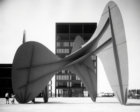Dave Burk was quite familiar with SOM’s work before joining the firm in 2019 as our photographer. An architecture fan and Chicago native, Burk grew up with SOM towers in the backdrop to his daily life as a child before eventually taking an apprenticeship with the heralded photography firm Hedrich Blessing out of college. When business travel around the world came to halt at the onset of the COVID-19 pandemic, Burk was able to refocus his camera on the firm’s older works in his own backyard — a project he looks back on as one of the most fulfilling assignments of his career.
I’m based in Chicago, which has quite a few classic SOM buildings that are well cared for and culturally relevant to this day. Looking through our archives, I realized a lot of these buildings were photographed when they were under construction and when they were first occupied, but that was typically it. There have been editorial shots for articles about these buildings since then, but nothing commissioned by SOM.
When the pandemic hit, we couldn’t get access to the buildings we had scheduled shoots for and we couldn’t travel anywhere. Our team had already been talking about the idea to update the photography for some of our legacy buildings, and it seemed like the perfect opportunity to shift our focus from the present into the past. We wanted to show these buildings from new perspectives, with new contextual components, using new technologies. So we decided I would shoot Hancock Tower (now 875 Michigan Ave.), Sears Tower (now Willis Tower), Brunswick Building (now Cook County Administration Building), DeWitt-Chestnut Apartments (now Plaza on DeWitt), and the Inland Steel Building.

Growing up here, I remember coming downtown, walking out of the subway stations, and seeing these canyons of buildings that became a part of the fantasy world I was creating for myself as a child. I’ve applied that part of my subconscious to my craft as an architectural photographer — it’s allowed me to see them in a focused and attentive frame of mind.
I went to photography school out West, with the hopes of eventually traveling the world to take photographs like the ones I saw in National Geographic. I ended up taking an architecture photography course where we studied Ezra Stoller and Hedrich Blessing — no strangers to SOM’s buildings — and that’s when I realized it was the kind of photography where I could apply a creative part of myself while also understanding light and composition. It’s also how I learned that Hedrich Blessing was based in Chicago, so I went back home, put together a portfolio, and got hired there as an apprentice. I spent the next three years learning the craft, traveling the country, and expanding my knowledge of architecture and design. I then became a staff photographer and was able to apply all of those experiences to my work.
That classic approach to architectural photography I learned from Hedrich Blessing is part of my DNA. I was there when they were still shooting with large-format film — the big cameras with the hood, the polaroids, 4×5 film — it was a true craft. You had no choice but to understand light and find the clearest and most powerful compositions of the design. That formal approach is still the backdrop from which I see architecture, but now I’m able to bring my own style through new technologies. A successful architectural photograph is sympathetic to the design while also embracing its surroundings. Having people in photographs adds scale, energy, and humanity. I want to portray the building as part of the world in which it was designed for, instead of isolating it as was so common in the past.


Chicago is set up on a north-south-east-west grid that makes it perfect for photography because you can gauge the sun at every time of year and know exactly where it will be. There’s a consistency to the light in every season — where it’s rising, where it’s setting, how it applies to the street grid. When it’s time to photograph a project, my first approach is to scout it out and see how the light hits it at different points in the day. Once I get an understanding of the light, I look around for different vantage points. Building rooftops, parking garages, train platforms, and other elevated spaces all add new and interesting perspectives. As I move through the city at different times of year I catch the light hitting the buildings — and their materials — differently. You get these sightlines at different points where certain buildings stick out, where certain streets terminate on a building. When I serendipitously catch one of those special moments with a SOM building, I log it in my head and make a note of the best time to capture that in a photograph later.
When you’re dealing with these iconic buildings, you have to respect them and approach it in a formal way that celebrates the architecture. Keep it simple. The building is sitting there, it’s beautiful, everyone already knows it; so don’t overthink it and do something crazy that’s going to be hot on social media. The simple shots are the most successful ones for this kind of architecture.

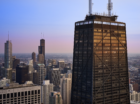
Our approach was threefold: New perspectives, new technology, and new contexts. My time shooting the Hancock Tower best represents that.
I rarely reference other photos of a project before I go shoot it. But with Hancock, it’s hard not to know the iconic black and whites from Esto and Hedrich Blessing, so it was fun to find those compositions from 50 years ago and shoot them in 2020. The city has changed so much around Hancock since it opened that it creates a fascinating juxtaposition with the older shots. And because of all that new development it was really hard to show the entire building from its antenna to the street, so we had to think of other ways to let the building shine without showing all of it at once.

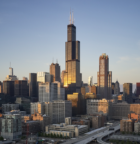
With tall buildings, I always find it cool to get close to the top and just get a subsection of it and everything else behind it; I went to some of the newer buildings around Hancock to get new vantage points, focused on its revolutionary x-bracing, figured out where light changes the building’s appearance at different points in the day, and even used a drone. Hancock has been shot a million times by helicopter and captured by other peoples’ drones, but for SOM to contain a set of those from that perspective was new and really fun to pull off. And because it’s so close to Lake Michigan, I had a lot more freedom with the drone to explore the airspace in a way that I couldn’t with some of the other towers. I was able to use parks and running paths in order to compose vignettes of everyday life in Chicago with our tower soaring in the backdrop and making a really strong statement.
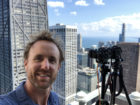
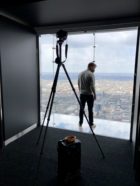
When I work on a project at SOM I’m able to fully engage with a single subject. To do that with these classic Chicago buildings allowed me to become far more intimate with them than ever before. Because of the circumstances caused by the pandemic, I was able to dive deeper and see these buildings in a way that would have been hard with a full workload. It ended up being one of the most fulfilling photo assignments of my career.
This article originally appeared on Medium.
Top image: The John Hancock Tower, as seen in the summer of 2020.


